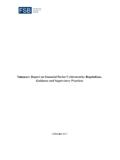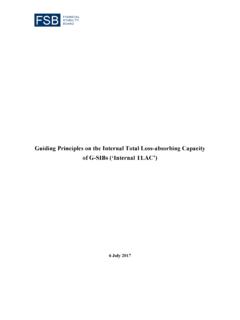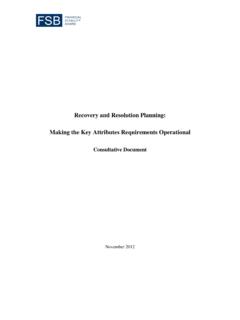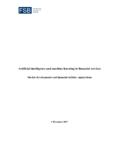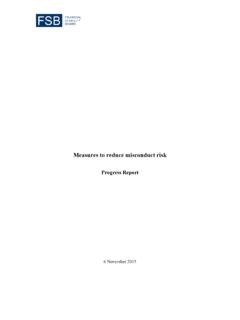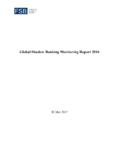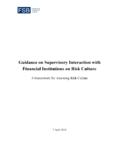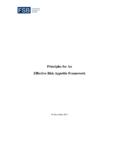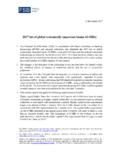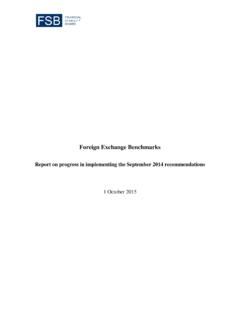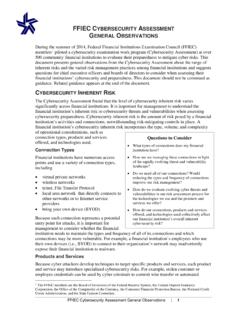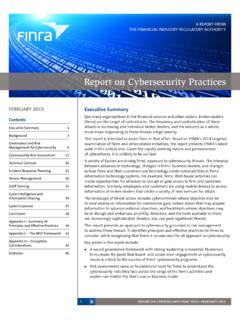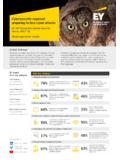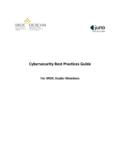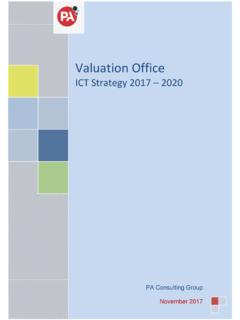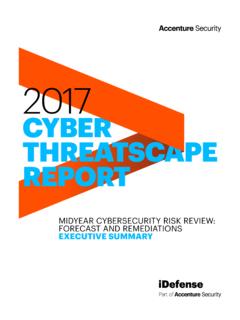Transcription of Stocktake of Publicly Released Cybersecurity …
1 Stocktake of Publicly Released Cybersecurity regulations , guidance and supervisory Practices 13 October 2017 The Financial Stability Board (FSB) is established to coordinate at the international level the work of national financial authorities and international standard-setting bodies in order to develop and promote the implementation of effective regulatory, supervisory and other financial sector policies. Its mandate is set out in the FSB Charter, which governs the policymaking and related activities of the FSB. These activities, including any decisions reached in their context, shall not be binding or give rise to any legal rights or obligations under the FSB s Articles of Association.
2 Contacting the Financial Stability Board Sign up for e-mail alerts: Follow the FSB on Twitter: @FinStbBoard E-mail the FSB at: Copyright 2017 Financial Stability Board. Please refer to: iii Table of Contents Executive Summary .. 1 1. regulations , guidance and supervisory practices in FSB member jurisdictions .. 5 Introduction .. 5 Reported regulations , guidance and supervisory practices .. 10 regulations and guidance generally .. 12 regulations and guidance that address operational risk .. 18 regulations and guidance targeted to Cybersecurity and/or IT risk .. 19 supervisory practices .. 23 Reported Future Plans .. 29 Reported Effective Practices .. 30 2. guidance and other work of international bodies .. 32 guidance issued by international bodies.
3 32 Other publications of international bodies .. 40 Future plans .. 41 Annex A: Additional Tables .. 44 Annex B: Glossary of Existing National and International guidance and Standards .. 49 Annex C: Summaries of Jurisdiction Responses to FSB Survey .. 51 iv 1 Executive Summary Cyber attacks are a threat to the entire financial system. The changing nature of, and growth in, cyber risk to financial institutions is driven by several factors, including evolving technology; interconnections among financial institutions and between financial institutions and other external parties; determined efforts by cyber criminals to find new methods to attack and compromise information and communications technology (IT) systems; and the attractiveness of financial institutions as targets for cyber criminals seeking illicit financial gains.
4 Authorities across the globe have taken regulatory and supervisory steps designed to facilitate both the mitigation of cyber risk by financial institutions, and their effective response to, and recovery from, cyber attacks. This is a report of an FSB Stocktake of existing Publicly available regulations and supervisory practices with respect to Cybersecurity in the financial sector, as well as of existing international guidance . The G20 Finance Ministers and Central Bank Governors (Ministers and Governors) requested the FSB Stocktake and report at a March 2017 meeting in The report is based on responses of FSB member jurisdictions and international bodies to a survey undertaken by the FSB in the spring of 2017. All 25 FSB member jurisdictions responded to the In addition, nine international body members and the G7 Cyber Expert Group submitted survey The report includes information concerning jurisdictions self-reported existing Publicly Released regulations , guidance and supervisory practices; future plans; and views regarding effective regulatory and supervisory The report also contains information regarding international bodies self-reported guidance , other publications and future plans.
5 It also includes three Annexes, namely, Additional Tables containing survey responses (Annex A), a Glossary of existing international guidance and standards (Annex B) and narrative summaries of each individual jurisdiction s response to the FSB survey (Annex C). The conclusions from the Stocktake include the following. FSB member jurisdictions have been active in addressing Cybersecurity for the financial sector. All 25 member jurisdictions report that they have Publicly Released regulations or guidance that address Cybersecurity for at least a part of the financial sector, and a majority have also Publicly Released supervisory practices. All or nearly all jurisdictions have addressed 1 See blob=publicationFile&v=3.
6 2 The FSB member jurisdictions are Argentina, Australia, Brazil, Canada, China, France, Germany, Hong Kong, India, Indonesia, Italy, Japan, Korea, Mexico, Netherlands, Russia, Saudi Arabia, Singapore, South Africa, Spain, Switzerland, Turkey, United Kingdom, United States and the European Union. 3 This includes the Basel Committee on Banking Supervision, Committee on the Global Financial System, Committee on Payments and Market Infrastructures, International Association of Insurance Supervisors, International Accounting Standards Board, International Monetary Fund, International Organization of Securities Commissions, Organisation for Economic Co-Operation and Development and the World Bank. 4 For purposes of the FSB survey, generally regulations and guidance were defined as materials that impose requirements on, or provide guidance for, regulated entities; and supervisory practices were defined as practices that supervisory authorities or regulators use in their oversight or examination of regulated entities.
7 2 banks and financial market infrastructures (FMIs), and a majority have addressed trading venues, insurance companies, broker-dealers and asset managers. FSB member jurisdictions report a significantly higher number of Publicly Released regulatory schemes than Publicly Released supervisory practices schemes. It is important to note, however, that some supervisory practices may not have been Publicly Released , and therefore were out of scope of the Stocktake . International bodies also have been active in addressing Cybersecurity for the financial sector. The 10 international bodies that responded to the FSB survey reported published guidance covering electronic banking; FMIs; firms and supervisory and regulatory authorities throughout the financial sector; critical information infrastructures, including financial sector actors that are critical information infrastructures; and all economic and social activities, across all sectors, from businesses, governments and individuals.
8 All FSB member jurisdictions report drawing upon a small body of previously developed national or international guidance or standards of public authorities or private bodies in developing their Cybersecurity regulatory and supervisory schemes for the financial sector. This suggests that jurisdictions have found the existing guidance and standards to be useful and that there is some degree of international convergence in Cybersecurity regulation and supervision of the financial sector. The number of schemes of regulations and guidance addressing Cybersecurity for the financial sector varied widely across jurisdictions. All member jurisdictions reported at least one regulatory scheme, with some reporting as many as 10. It is difficult to draw particular conclusions from the number of schemes reported.
9 For example, there was no direct correlation between the number of schemes reported by a jurisdiction and the financial subsectors covered. Jurisdictions reported that their regulatory schemes more commonly took a targeted approach to Cybersecurity and/or IT risk (66% of reported schemes) and less commonly addressed operational risk generally (34% of reported schemes). By financial subsector, the percentage of reported regulatory schemes targeted to Cybersecurity and/or IT risk ranged from a high of 83% for trading venues to a low of 60% for asset managers. For FMIs and banks, the percentages of reported targeted regulatory schemes were 77% and 71%, respectively. Regulatory schemes categorised by jurisdictions as addressing operational risk often were characterised as principles-based, risk-based or proportional and specified the objectives to be met by regulated institutions.
10 Nonetheless, many operational risk schemes enumerated a number of elements to be addressed by regulated institutions, commonly including governance; risk assessment and risk management; policies, procedures and controls; prevention, detection and reduction of vulnerability; protection of information; security tests; backup sites and disaster recovery; business continuity planning; notice to regulators; independent review; and third-party risks. There were 56 schemes of regulations and guidance reported as targeted to Cybersecurity and/or IT risk, which covered a variety of content elements. Some of the elements covered by those schemes, listed in descending order by the number of schemes in which they were included, are risk assessment (55); regulatory reporting (50); role of the board (49); third-party interconnections (49); system access controls (48); incident recovery (46); testing (44); training (43); creation of role responsible for Cybersecurity , such as chief information security officer 3 (38); information sharing (31); expertise of the board or senior management (22); and cyber risk insurance (15).
